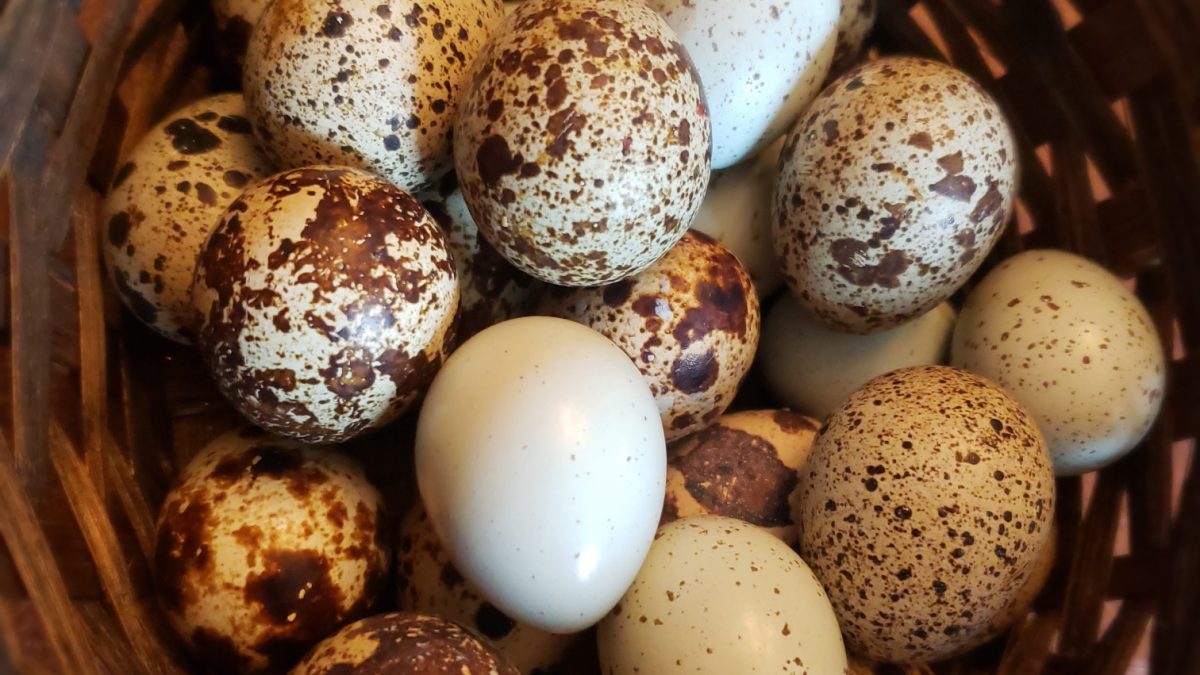
quail eggs are beautiful and delicious
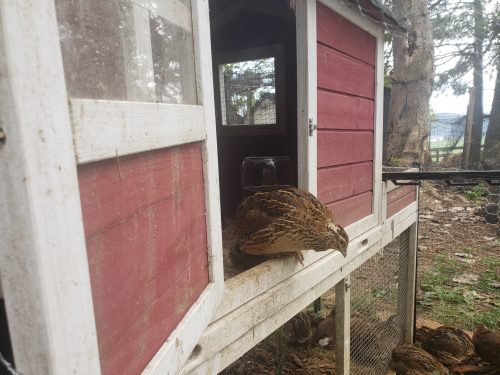
When people think about the first animal to add to their homestead, it is usually chickens. But what about quail? Quail are an often overlooked option, and a great addition for the urban and suburban homesteader as well as the individual with some acreage.
There are many different breeds of quail, from the striking Bobwhite to the Button Quail with its infinitesimally tiny eggs. My personal observation is that the Japanese (Coturnix) quail is a wonderful breed for beginners as well as those with a limited amount of space.
Why raise quail?
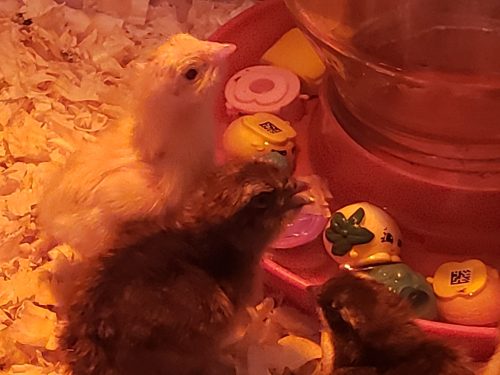
Quail chicks are cute and tiny
Quail can be raised for eggs, for meat, and for the sheer pleasure of watching these little ground birds in their incessant activity.
Unlike other poultry, quail can be kept in a very small space, including a garage, and are generally quiet. Males make a lovely trill when they crow, but they will typically not be noisy enough to induce the wrath of neighbors.
Quail mature quickly and will begin laying eggs as early as eight weeks (I’ve a friend who used artificial lighting on her quail, and they began to lay as early as six weeks). Their eggs are considered super foods, rich in iron and with a higher percentage of protein (13%), than a chicken’s egg (11% protein). Many consider quail eggs a delicacy and we’ve had a steady demand for them from our Ukrainian and Vietnamese friends especially, who frequently use them in their cooking. (Just know that you’ll need three or four quail eggs to equate the size of a chicken egg!)
Quail can also be used for their meat, which might be sparse compared to other poultry thanks to their size, but very tasty.
What you should know before getting into quail
- They are messy! For a little bird, they generate a lot of manure, and while it is nitrogen-rich and absolute gold for gardens, be prepared for a lot of poop.
- Quail are also messy eaters, and have a tendency to fling their food helter-skelter as they dive-bomb into it. There are various remedies for this, and one simple thing I do is to place a frisbee under their feeder which cuts down on wasted food.
- Quail also require a different feed than chickens if you want them to lay eggs. I give mine the same game bird feed that we use for our turkeys, containing a higher protein level than chicken feed.
- They can fly and will exit your brooder as early as one week old if you don’t cover it adequately (a lesson I learned experientially!).
- As babies, they’re tiny. Their crumble required me to grind it the first several days of their life (I used an old coffee grinder). Marbles (or in our case, Shopkins) had to be placed in their waterer so they didn’t drown.
- Unlike chickens and other poultry, quail are wild birds and their behavior reflects this. They tend not to covet human touch and interaction, and in fact are not opposed to pecking the hand that feeds them (despite being raised right from the egg, followed by two years of daily interaction and care from us). Unlike chickens, my quail cannot be left to free range as they do not have the sense to return to roost, nor can they be trusted to forage together in groups for safety as chickens do.
- Males may do fine together, particularly if there is an adequate male to female ratio (five or six hens to one roo). Nevertheless, be prepared for some macro-agression if you have boys together. In fact, they might do great for weeks on end and then one day out of the blue, you discover that an alpha male has made it his mission to pick on one of the others mercilessly. In this case you will need to be prepared to do one of two things: 1) separate the males into different housing or 2) process the offending party.
- Males are distinguished by their buff breast color, while females are speckled. In some cases, you will have color varieties that make it more difficult to sex (we hatched a single pure white quail which turned out to be female).
Housing Quail
Quail can be housed in simple wire pens, and some manufacturers sell stackable cages specifically designed for quail, with angled flooring which enables eggs to roll out onto trays for easy and sanitary collection.
I prefer whenever possible to keep our animals in a setting that is as near to their natural habitats as possible. We house our quail in a small coop with a ramp, surrounded by a run and topped with bird netting. In this way, the quail are able to enjoy scratching in the dirt, taking dust baths, and foraging. They also have the option to be off the ground in the coop and enjoy more space.
In winter, however, once the ground freezes, I do move my quail to the barn for protection and warmth. I purchased used pens that once housed pigeons, ensuring my quail have lots of space to run around. Although wire is easier to clean, I like my quail to have the option of being on surface area that’s gentler on their feet. I get thin cardboard free from a local business and place straw on part of it., While it means changing it out weekly, it is worth it to see them comfy, happy, and with insulation.
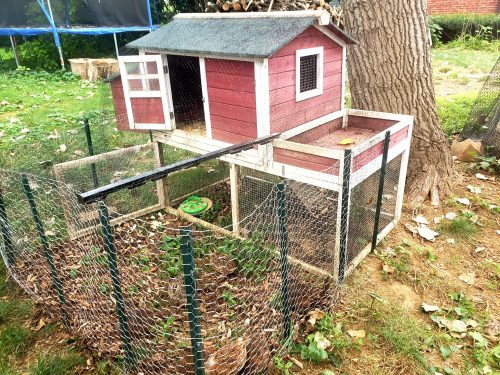
Quail can be housed indoors or out
Dust baths
One important feature you’ll want to offer your quail, regardless of how you house them, is the opportunity to take dust baths.
If they’re outside on the ground, quail will generally dig out their own little area in the dirt for dust baths. If you have them in wire pens, you can offer them a small plastic tub filled with dirt or diatomaceous earth (if using the latter, make sure it is food grade or it can be toxic to them). Dust bathing helps to minimize the lice, mites, and any other parasites that plague the birds. The dust also absorbs excess oils produced in the birds feathers.
My quail practically light up when they see me coming with fresh earth in their little tubs. As soon as it is placed in their pen, they hop in and begin scratching and burying themselves in the rich dirt, their delight evident!
Processing Quail
Quail meat I find superior in flavor and moisture to other poultry. On the menu of tapas restaurants, it can now be purchased from ranchers and whole food sites as well.
I personally do not raise my quail for meat. I have, however, processed them on occasion when we had an overabundance of males; I also helped a friend butcher and brine some of hers. Quail are relatively easy to process, their skin pulling apart seamlessly following quick decapitation by a sharp pair of poultry shearers. The most difficult part of the processing for me was the removal of the lungs. One quail, start to finish, can be done in under 10 minutes.(There are some internet videos which provide tutorials on how to go about this).
Just know that one bird is generally only enough for one person!
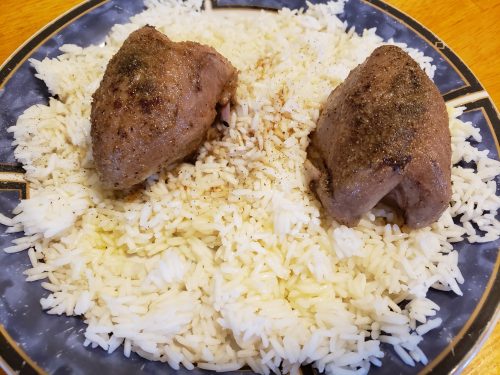
baked quail on rice
Where to purchase quail
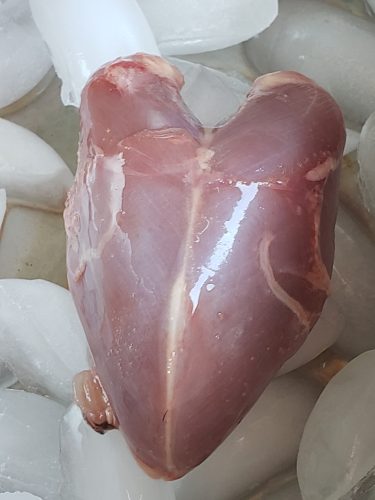
freshly processed quail on ice
Whether purchasing fertile eggs or live birds, do your homework before buying quail so you aren’t disappointed. I bought fertile quail eggs from a reputable organic farm in California and had a 65% hatch rate, despite the post office not following the instructions of the shipper and leaving the eggs out in a wintry mix for hours. You can generally find both fertile eggs and live birds on local sites and social media groups. Again, do some research to get an idea what breed will best suit you and to know what to expect in longevity, temperament, and production from your birds.
I’ve gotten more people started on quail than any other animal, and the feedback has been delightful. Have fun, and enjoy all the benefits or raising this beautiful bird!
